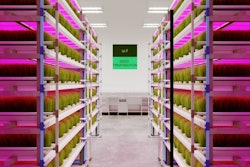
How transportation emissions policies will change the landscape for Americans in agriculture
Transportation accounts for nearly one-third of the U.S.’s greenhouse gas (GHG) emissions — the nation’s No. 1 source of total emissions.
Addressing transportation sector emissions is key to reaching the United Nations’ goal of economywide carbon neutrality by 2050. To that end, public and private investment in electric vehicles (EVs), battery production and EV charging station infrastructure has dramatically increased since 2020.
Accelerating the adoption of EVs will improve the nation’s carbon footprint, but it will also affect all industries that rely on transportation, including the feed industry, as well as the workforce.
Feed mills and feed mill employees of the future may experience transportation entirely differently than they do today.
“Fully electric is going to be the future, where we’re not using fossil fuels to work with our land and we’re able to sequester more carbon than we’re taking out of planet Earth,” said Ethan Gill, researcher, Harper Adams University, an expert on the future of agriculture.
Examining U.S. electric vehicle policies, the shortcomings of these policies, and the wide-ranging applications for EV and autonomous vehicles offers feed industry stakeholders insights into where alternative transportation may someday lead.
EV policies usher a new era in transportation
In 2020, the California Air Resources Board (CARB) announced that by 2035, all new cars, pickups and SUVs sold in the state must be electric or plug-in hybrid electrics (PHEVs). California has the strictest vehicle emissions standards in the country, but the ruling has nationwide implications, with 17 other states tied to CARB’s emission standards.
Rule makers in each of the 17 states must now independently weigh the decision whether to follow CARB’s lead. Meanwhile, President Joe Biden’s goal is for EV sales to make up 50% of new cars, pickups and SUVs in the United States by 2030.
To meet this goal, U.S. auto companies have announced US$13 billion of investments in EV manufacturing capabilities and US$24 billion in investments for battery materials and production.
In January, a House Agriculture Committee hearing presented testimony from key stakeholder groups, including auto makers, electric companies, renewable fuels producers, car dealerships and convenience stores, on how the enormous investment and push for EV will affect rural America.
As most U.S. feed manufacturing facilities are in rural settings, policies that could potentially inhibit the rural workforce must be carefully weighed.
Changing landscape: electric vehicles for the rural workforce
David L. Strickland, vice president, global regulatory affairs, General Motors, testified before the House Agriculture Committee in January that the American auto manufacturer is ready to meet the transportation needs of rural Americans.
“At General Motors, our vision for the future is a world with zero crashes, zero emissions and zero congestion,” Strickland said. “The key to unlocking that vision is automobile electrification. Building an inclusive, all-electric future is the right thing to do for the world, U.S. competitiveness and our company. We’re committed to bringing everybody in on this future, and we are working hard to ensure we leave no community behind.”
At the 2022 Consumer Electronics Show, GM revealed the Chevrolet Silverado EV, an electric pickup truck claiming to deliver the strength, durability and performance the brand is known for, built on GM’s Ultium battery platform. The Silverado EV has a GM estimated range of 400 miles on a full charge.
“With 664 horsepower, our customers in rural America will find it satisfies all their needs, both on and off the farm,” Strickland said.
Other EV trucks on the market, like the Ford F-150 Lightning, offer advantages like the ability to power tools or an entire house for days, if needed. Another worthy competitor by payload and battery capacity is the Rivian R1T, American made by a startup in Normal, Illinois.
Addressing application needs of the rural workforce with EV solutions is one prong of the net-zero transportation solution, but widespread adaptation of EVs throughout the U.S. also relies on a dependable network of charging stations.
EV charging infrastructure to expand
In order for vehicle electrification to be fully embraced by the agriculture industry, care must be taken to eliminate charging deserts in rural communities.
During the hearing on EV policies’ impact on agriculture, Committee Chairman Rep. David Scott acknowledged the “range anxiety” — or fear associated with running out of battery charge while driving an EV — created by our charging infrastructure.
“Between Macon and Savannah [Georgia], which is a 170-mile-stretch of urban America, drivers pass only four charging stations just off the interstate, according to the website plugshare,” Scott said. “This is why we’re here to make sure that we know what we’re getting into.”
In order to bring EV charging predictability, reliability and accessibility to drivers, the Bipartisan Infrastructure Law includes a US$7.5 billion investment in building a national network of 500,000 new stations.
While our established retail fuel network may seem like the logical location for new EV charging stations, several challenges exist for fuel retailers, including agriculture cooperatives, to profitably enter the EV charging market.
Trevor Walter, vice president of petroleum supply management for Sheetz Inc., testified on behalf of the National Association of Convenience Stores (NACS) before the House Agriculture Committee on the impediments fuel retailers face by investing in charging stations.
“Most of these impediments involve an electricity market structure that was not designed for and is —not surprisingly — incompatible with the competitive retail fuel market,” Walter said. “What’s more, many regulated utilities want to bill EV charging station owners more money for electricity than their own cost.
“If these efforts persist, fuel retailers will not consider EV charging stations to be an attractive investment. No amount of grant money or tax incentives will change that fundamental reality,” Walter said.
Auto manufacturer GM testified it would offer greater charging accessibility by developing a community charging program with more than 4,000 GM dealers and the installation of up to 40,000 Level 2 destination chargers at key locations throughout communities, including rural areas.
“This is significant because nearly 90% of the U.S. population lives within 10 miles of a GM dealership,” Strickland said. “These charging stations will be available to all EV customers, not just those who purchase a GM EV. It is critical that America’s charging infrastructure be an interoperable network.”
Non-road EVs and autonomous EV predictions
Additional opportunities to reduce carbon emissions of the overall supply chain exist through the electrification of non-road vehicle fleets.
Southern Companies, an energy provider located in Atlanta, is involved in research and development for on-road and non-road electric and alternative fuel transportation. Southern Companies’ Lincoln Wood, electrification policy manager, testified at the Ag Committee hearing that clean transportation policies can benefit businesses in every sector and U.S. region.
Southern Companies has taken the lead in electric conversion with its own non-road fleets, including forklifts, all-terrain vehicles, carts and the miscellaneous equipment segment. The company has pledged to convert 50% of these “light-duty” fleet vehicles, which also includes the auto/SUV/minivan category, to electric by 2030.
Through its annual fleet attrition process, each year it will select which internal combustion engine fleet assets to retire and will replace them with clean fuel alternatives.
The electrification of non-road vehicle fleets may even usher in autonomous — or self-driving —applications for feed mills.
Driven by the need to improve worker safety and fill labor gaps, Gill, of Harper Adams University, envisions the growth of autonomous machines across agriculture. Picking machines as small and compact as a drone are used in produce fields and retail warehouses today, and may make their way into feed mill warehouses.
“Autonomous machines working together in agriculture will take away the dull, dirty, dangerous tasks to make things safer for us,” Gill said. “Autonomous machines can do things better than we can. It means we’re able to run operations for a longer period of time and keep working. With that, it’s going to take away some of the lifting aspects and the heavy, burdensome tasks that we physically do as people.”
Gill said the shift to autonomous non-road EVs in agriculture will be due to advances in direct drive motors and battery technology.
“That has allowed autonomous machines to start working in the agricultural environment,” he said. “It’s absolutely perfect for a small, non-aggressive looking machine to go out there and start doing tasks which are really needed.”
With California leading the charge on stricter vehicle emissions standards, the EV and hybrid wave is coming to rural businesses and the workforce. Investment in EV manufacturing and charging infrastructure will likely bring permanent changes to the rural transportation landscape.
Agribusinesses that commit to converting company-issued trucks and cars to electric will be rewarded with incentives, while contributing to reducing their transportation-related carbon footprints.
Other programs to convert non-road vehicle fleets from internal combustion engines to electric power can also play a meaningful role in reducing carbon emissions for feed manufacturers. Continued investment in EV manufacturing and infrastructure by various stakeholders will undoubtedly affect the rural workforce and agriculture for decades to come as all industries work together to achieve carbon neutrality by 2050.


















